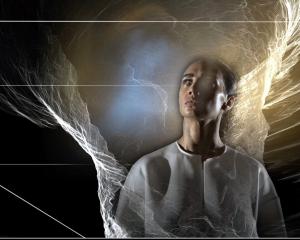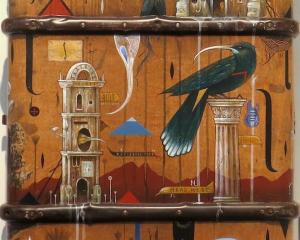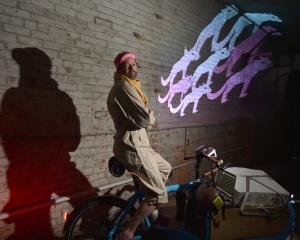
Being a wife and mum, getting a master's degree, applying for funding and choreographing new work, it is no wonder Sarah Foster-Sproull's work reflects how complicated life has become.

The former Otago Girls' High School pupil's new work, Super Ornate Construct, is one of two pieces being performed by Footnote dance company on its ''Contrast'' tour of New Zealand, which finishes in Dunedin this weekend.
Foster-Sproull began dancing when she was 6 at Dunedin School of Ballet, taught by Robyn Sinclair. She learnt ballet and jazz.
''I couldn't get enough of it, to be honest.''
She did not realise it could be a career, though. Growing up, she had thoughts of becoming a lawyer, but a series of events led her to the New Zealand School of Dance, of which she has been named a distinguished graduate.
''I thought, 'I really love this', so I kept doing this.''
She went on to positions with Raewyn Hill and Soapbox Productions, the Douglas Wright Dance Company, Michael Parmenter and Commotion Company - ''my heroes'' - and the New Zealand Dance Company, among others.
In 2008 she was named best female performer at the Tempo Dance Festival for her role in Parmenter's Tent.
She is also a professional teaching fellow in the University of Auckland's dance studies programme and teaches contemporary technique at Unitec Performing and Screen Arts.
Foster-Sproull is also a guest teacher at the New Zealand School of Dance and has tutored at Douglas Wright Dance, Atamira Dance Company and Footnote New Zealand Dance, among others.
After 18 years on the dance floor, she felt it was time to focus on her own dance work.
''I found I had an affinity with making choreography, and a lot of the process I had been involved in as a dancer, I was asked to contribute choreographic material to the work and it was one of my most favourite things to do.
''So I thought it might be a good idea to take some responsibility creatively for that, for the driving vision of the choreographed work.''
She started experimenting with making her own work.
While it is hard for her not to be dancing any more, she appreciates not having to go through the ''the terrible'' performance anxiety she used to suffer.
''I do miss dancing. I was always very nervous before performing so I'm somewhat relieved not to go through that roller-coaster of performance anxiety. It's part of the job.
''I danced for about 18 years, so throughout that career I dealt with it.''
This does not mean choreography and presenting her own work is without its nervous times and pressures.
''Is the vision I have developed going to be received the way I hope. Whether my ideas will be read clearly. Whether I have the ability to continue to work and present work in New Zealand.''
They are more career-related concerns, but they drive her to produce high-quality choreography.
''I want to ensure I can continue to do this. Each work, I put a tremendous amount of pressure to put on a high-quality work. I really care about the art form.''
Part of that was doing the extensive work required to apply for the Creative New Zealand Choreographic Fellowship that she won this year.
''I've been working towards this my whole career.''
She was described by the assessment panel as ''one of New Zealand's most compelling, innovative and creative choreographers''.
The $100,000 two-year fellowship will allow her to collaborate with international dance companies in Fiji, Perth and Edinburgh and develop a new Auckland-based dance company for graduates.
''This is a once-in-a-lifetime opportunity for me. I plan to push, experiment, reflect upon, and provoke new approaches to my choreographic practice.
''This has a huge impact on my life.''
The fellowship comes on the heels of being chosen in 2015 as one of five international choreographers to participate in the ''Craft of Embodiment'' workshop in Canada and a residency in Singapore with T.H.E Second Company, supported by Asia New Zealand Foundation and Creative New Zealand.
At the time she had a 6-week-old baby and a 6-year-old with her but had the help of her husband, Andrew Foster, and mother.
''There is a lot of juggling and organisation involved to ensure the work can keep going.''
Earlier this year, she also submitted her master of dance studies thesis through the University of Auckland's dance studies programme.
''I did that while having a newborn baby and making dance work.
''When you're a mum you just get things done, even with the chaos around you. That's absolutely fine.''
Being a mother has changed Foster-Sproull, especially as most of her work has a humanistic approach and investigates relationships between people.
''Having to care for someone and put all of my issues and concerns aside in order to do that to look after my two children, to put their needs first, has changed everything for me.
''It has also given me a drive to contribute something poetic and meaningful to society. Because I'm aware life is precious.''
Before she became a mother, she was more ''flippant'' about things.
''When I was younger I was more interested in making something look cool; now it's about making something that has worth contributing to the discussion.
''I'm totally cool with it.''
She also enjoys working with her family - Andrew Foster composed the music for Super Ornate Construct and her daughter Ivy took part in a recent work, Orchids.
Super Ornate Construct is about societal constructs and how complicated life has become, she says.
''Essentially, when you strip it all back, life potentially is about people and relationships between people. There may be simplicity in that.
''This work tries to overcomplicate itself in order to strip itself back in the end.''
''It also looks at the characters - the stereotypical man alone archetype and have worked to put him as a character in a whole lot of circumstances with other people.
''Then we do power shift from the man alone to the idea of the woman alone, whatever she might be.
''There is a number of streams running through the work. One is about relationships, another is about gender.''
She found putting the piece together with a narrative very satisfying.
''My husband is a theatre maker so I see a lot of theatre, so I'm always trying to marry text with dance. The dancers don't speak but there is narration that comes in again and again to add context.
''That's a really exciting experience for me. It's not like any other work I've made. The movement has the same sense of movement style I like.''
She made a lot of the props the dancers use in the piece. The dancers juggle a lot from the narrative to the props, she says.
''It's been a lot of work and really labour intensive. It doesn't magically happen; it is hard graft that actually gets those dancers to the performance stage.''
It was also good to be making work for Footnote, she said.
''Deidre Tarrant [founding director of Footnote] gave me my first professional choreographic commission, so I have a strong loyalty to the company.''
Footnote dancer Joshua Faleatua said he was excited to perform in Foster-Sproull's work.
''It's such a massive contrast [to Emma Murray's work, the other piece on the 'Contrast' programme], as it's mapped out; all the little details are choreographed.''
It is the first major tour with the company for Faleatua, who was born in Pleasant Point but grew up in South Auckland.
He comes from a hip-hop-breakdance background and did not think of dance as a career option until he went to university.
''I didn't really know there were other dance styles than hip-hop.''
Once he discovered contemporary dance and the freedom and career opportunities it provided, there was no turning back.
''I soon realised I could be a dancer and it not just be a hobby. It lined up more with what I wanted personally.''
He finished university last year and took part in Footnote's Choreolab, an intensive three-week course.
''That developed my relationship with Footnote. I experienced my first contract and show.''
That led to an internship with Footnote, which he described as an ''amazing'' experience.
So he then auditioned for his latest role and got the job.
''It's where I wanted to go. There are always new experiences.''
He is enjoying the work and is learning to pace himself and conserve his energy to get through the shows.
''They're really interesting works to perform.''
To see
Footnote: ‘Contrast’’, Mayfair Theatre, Saturday, November 11, 7pm.
An excerpt from the programme will be included in a short performance at Dunedin Public Art Gallery at 1pm the same day.












